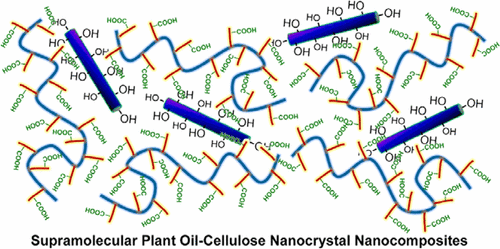当前位置:
X-MOL 学术
›
Macromolecules
›
论文详情
Our official English website, www.x-mol.net, welcomes your
feedback! (Note: you will need to create a separate account there.)
Supramolecular Polymer Nanocomposites Derived from Plant Oils and Cellulose Nanocrystals
Macromolecules ( IF 5.1 ) Pub Date : 2017-09-25 00:00:00 , DOI: 10.1021/acs.macromol.7b01691 Lingzhi Song 1 , Zhongkai Wang 1, 2 , Meghan E. Lamm 2 , Liang Yuan 2 , Chuanbing Tang 2
Macromolecules ( IF 5.1 ) Pub Date : 2017-09-25 00:00:00 , DOI: 10.1021/acs.macromol.7b01691 Lingzhi Song 1 , Zhongkai Wang 1, 2 , Meghan E. Lamm 2 , Liang Yuan 2 , Chuanbing Tang 2
Affiliation

|
Sustainable functional materials derived from renewable biomass provide momentum for the communities of polymer science. We report a supramolecular approach to the preparation of strong biobased polymer nanocomposites with stimuli-responsive behaviors using soybean oil (SO) and cellulose nanocrystals (CNCs). SO-derived polymers were modified with hydroxyl −OH and carboxyl −COOH groups via thiol–ene click chemistry, facilitating hydrogen-bonding interactions with CNCs to improve the overall compatibility in the nanocomposites. These nanocomposites exhibited high tensile strength and maintained high storage modulus up to 200 °C. Moreover, these nanocomposites showed a fast and reversible mechanical response to water, an external stimulus to tune intermolecular hydrogen bonding.
中文翻译:

源自植物油和纤维素纳米晶体的超分子聚合物纳米复合材料
源自可再生生物质的可持续功能材料为聚合物科学界提供了动力。我们报告了一种超分子方法,以使用大豆油(SO)和纤维素纳米晶体(CNCs)制备具有刺激响应行为的强生物基聚合物纳米复合材料。SO衍生的聚合物通过硫醇-烯点击化学方法被羟基-OH和羧基-COOH基团改性,促进了与CNCs的氢键相互作用,从而改善了纳米复合材料的整体相容性。这些纳米复合材料显示出高拉伸强度,并保持了高达200°C的高储能模量。此外,这些纳米复合材料显示出对水的快速和可逆的机械响应,水是一种外部刺激,可调节分子间的氢键。
更新日期:2017-09-25
中文翻译:

源自植物油和纤维素纳米晶体的超分子聚合物纳米复合材料
源自可再生生物质的可持续功能材料为聚合物科学界提供了动力。我们报告了一种超分子方法,以使用大豆油(SO)和纤维素纳米晶体(CNCs)制备具有刺激响应行为的强生物基聚合物纳米复合材料。SO衍生的聚合物通过硫醇-烯点击化学方法被羟基-OH和羧基-COOH基团改性,促进了与CNCs的氢键相互作用,从而改善了纳米复合材料的整体相容性。这些纳米复合材料显示出高拉伸强度,并保持了高达200°C的高储能模量。此外,这些纳米复合材料显示出对水的快速和可逆的机械响应,水是一种外部刺激,可调节分子间的氢键。











































 京公网安备 11010802027423号
京公网安备 11010802027423号